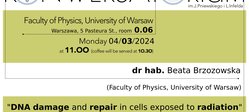
Open lecture
DNA damage and repair in cells exposed to radiation
dr hab. Beata Brzozowska
Wydział Fizyki Uniwersytetu Warszawskiego
March 4, 2024, 11 a.m.
ul. Pasteura 5, sala 0.06
On Monday, March 4, at 11.00 AM, Jerzy Pniewski and Leopold Infeld Colloquium of the Faculty of Physics will be held in room 0.06.
The lecture entitled: "DNA damage and repair in cells exposed to radiation" will be delivered by dr hab. Beata Brzozowska (Faculty of Physics, University of Warsaw).
The lecture will focus on the effects that radiation of different nature has on the DNA code of living organisms. Among others, we will learn that contrary to widespread opinion, the impact is not always harmful.
Before the Colloquium, from 10.30 AM, please join us for informal discussions over coffee and cakes in the lobby outside room 0.06.
The dates of the Colloquium in the second semester are 4 III, 22 IV, 27 V, and 10 VI.
With best regards,
Barbara Badełek
Jan Chwedeńczuk
Jan Kalinowski
Jan Suffczyński
dr hab. Beata Brzozowska (Faculty of Physics, University of Warsaw)
DNA damage and repair in cells exposed to radiation
DNA is the fundamental molecule encoding and storing the genetic information of all living organisms. DNA damage and repair is by essence a multidisciplinary line of research, and it is one of the main topics of medical physics studies performed in Radiobiological Laboratory at Faculty of Physics, University of Warsaw. The genetic material is a labile substance that is constantly damaged either spontaneously or due to the action of DNA damaging agents like ionising radiation.
During colloquium I will discuss the results of experiments performed with cells exposed to radiations, which differ in the way how interactions are distributed inside a nucleus. While X-rays are sparsely ionizing, alpha particles hit cells in a highly condensed manner, as single tracks. A combined exposure places the cell in a particularly difficult situation of experiencing both hit scenarios which leads to the formation of clustered damage posing serious problems for the DNA repair machinery.

